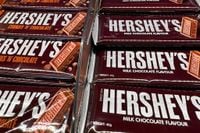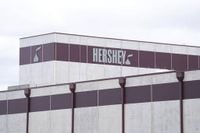Chocolate lovers across the United States are bracing themselves for a noticeable increase in the price of their favorite treats this fall, as The Hershey Company confirmed it will be raising prices on its candy products by a low double-digit percentage. The Pennsylvania-based confectionery giant, known for iconic brands such as Reese's Peanut Butter Cups, Kit Kat, Hershey's Kisses, and York, announced on July 23, 2025, that the price hikes are a response to soaring ingredient costs, particularly the unprecedented rise in cocoa prices, rather than tariffs or trade policies.
Hershey's spokesperson emphasized that the price increase will affect a broad range of products across its portfolio but reassured consumers that Halloween candy will remain exempt from these changes this year. "We're committed to delivering the treats consumers love while continuing to invest in making our products and experiences even better," the spokesperson said. They added that Hershey has worked hard to absorb rising costs for years, maintaining 75% of its product portfolio priced under $4.00 to keep treats accessible and affordable for families nationwide.
The timing of the price adjustments is particularly significant, with increases expected to take effect in approximately 90 days, coinciding with the lead-up to the Halloween candy season. This strategic timing has raised concerns among consumers about the impact on holiday shopping budgets.
The root cause of these price increases lies in the volatile global cocoa market. Cocoa prices have more than doubled since 2023, with futures hitting a peak of nearly $12,000 per metric ton in December 2024 before settling around $7,380 per metric ton in late July 2025, according to the International Cocoa Organization. Despite this recent decline, prices remain 121% higher than two years ago, reflecting a sustained period of elevated costs.
West Africa, which supplies over 70% of the world's cocoa beans, has been at the heart of the supply challenges. The Ivory Coast and Ghana, the region’s two largest producers, have struggled with poor weather conditions, including heatwaves and heavy rains linked to climate change, which have fostered the spread of diseases such as Black pod rot. These factors, combined with aging cocoa tree stocks and the damaging effects of small-scale gold mining, have severely impacted cocoa yields.
Industry experts also point to chronic underinvestment in West African cocoa farms as a key driver of the crisis. Tracey Allen, an agricultural commodities strategist at J.P. Morgan, explained, "Cocoa is a market where the grower produces a very high-value good but receives a very low share of the actual value chain. As a result, replanting rates of diseased trees are low and West African yields have been more subject to weather impacts." This structural problem has exacerbated the supply shortages and price volatility.
The cocoa situation remains highly volatile. Prices surged again in early June 2025 due to concerns about production in the Ivory Coast, eased on optimistic forecasts for Ghana and Latin America, but then rose once more following heavy rains in West Africa that risk worsening crop diseases, underscoring the fragile state of the market. Cloetta, a Swedish confectionery company, highlighted the unpredictability of the market, with their CFO Frans Ryden stating, "This is something that’s moving hugely up and down all the time."
Other major chocolate manufacturers have also been forced to raise prices amid these challenges. Swiss chocolatier Lindt & Sprüngli raised prices by 15.8% in the first half of 2025, as CEO Adalbert Lechner noted the continuation of high cocoa prices from 2024 into 2025. Similarly, Mondelez International, the owner of Oreo and Cadbury, announced planned price increases earlier this year citing rising cocoa costs. Nestle has also raised prices on products such as Toll House chocolate chips in the spring of 2025.
Hershey’s price hikes are expected to range generally between the low teens and 20%, with the company informing its retail customers in mid-July 2025 of the upcoming changes. Despite these increases, the company aims to keep most products affordable, with three-quarters of its confection portfolio priced under $4.00. This approach reflects Hershey’s strategic vision to navigate the cocoa inflation by leaning into "less cocoa intensive" products and expanding into other snack categories such as sweets, better-for-you options, and salty snacks, as outlined by then-President Michele Buck in a May 2025 earnings call.
Chocolate candy remains a significant part of Hershey’s business, accounting for 67% of sales, while non-chocolate candy makes up about 12%, according to an April 2025 analysis by TD Cowen. The company has also been actively managing the volatility in cocoa prices through commodity derivatives markets, entering contracts to purchase cocoa at fixed prices in the future to hedge against sudden price spikes.
Despite the price increases, Hershey executives report that consumer demand has remained strong. The company’s shares have risen over 7% in 2025, reflecting investor confidence in its ability to manage inflationary pressures. However, the rising cost of chocolate is already impacting consumer behavior. Nielsen IQ data shows that the average price of a chocolate bar in the U.S. rose from $2.43 in July 2021 to $3.45 in July 2025, a 41% increase, contributing to a 1.2% decline in chocolate unit sales over the past year.
Complicating the situation, U.S. trade policies have added uncertainty to the cocoa market. President Donald Trump threatened a 21% tariff on cocoa and other products from the Ivory Coast in April 2025 but later paused its implementation. The National Confectioners Association has been lobbying for tariff exemptions to protect the chocolate industry, highlighting that the U.S. imports nearly $4.4 billion in chocolate, cocoa, and candies annually, while exporting nearly $2 billion in American-made chocolates and candy.
As Hershey prepares for a leadership transition with Kirk Tanner, former Wendy's CEO, set to take over in mid-August 2025, the company faces the challenge of steering through these turbulent market conditions while maintaining consumer trust and product accessibility. Tanner will replace Michele Buck, who led the company through much of the recent inflationary period.
The coming months will be critical for Hershey and the wider chocolate industry as they balance rising costs, consumer expectations, and global supply uncertainties. For now, chocolate lovers might have to prepare for a slightly smaller or pricier treat but can take solace in Hershey’s commitment to keeping the Halloween candy aisle untouched this year.



